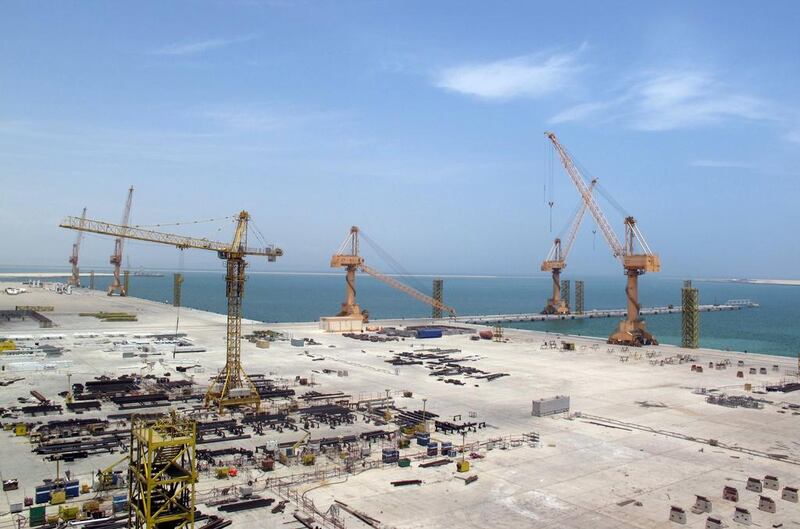MUSCAT // Oman is pinning hopes for its economic diversification plan on the formerly sleepy fishing town of Duqm, transforming it — with the help of foreign investment — into a port and industrial hub that will be the engine of the country’s post-oil economy.
Like all GCC countries, Oman is grappling with the likelihood of a protracted era of low oil prices, but is especially vulnerable as its reserves will, by some estimates, run out in as little as 15 years. Like its Gulf neighbours, Oman has sold bonds to wipe out its budget deficit in the short term. But energy revenues still make up 83 per cent of its budget, and crucially, 62 per cent of the workforce is employed by the state.
Accelerating plans to grow the non-oil and gas private sector and make it attractive to Oman’s young and growing population is an imperative for Muscat.
With the actual budget deficit at 5.3 billion Omani rials (Dh52.1bn) in 2016 — proportionally the largest in the GCC — Oman has already announced it will borrow 2.5bn rials from domestic and international markets. The jobless total is estimated to hit 50,000 by the second half of this year and the World Bank estimates youth unemployemt to be higher than 20 per cent in a country where half the population is under 25.
Oman is revamping its ports infrastructure from Muscat to Duqm, Sohar and Salalah, to adapt them for tourism but more importantly to increase industrial production and exports, and to exploit the country’s strategic location to create a hub for international shipping. Regional powers such as China and India are interested in establishing commercial and strategic footholds in the free ports, and Oman aims to capitalise on what it hopes will be Iran’s economic integration into world markets.
Duqm, located 550km south of Muscat on a barren stretch of the coastal road, is the centrepiece of these plans. It was initially envisioned as a trade hub that would be connected to new rail networks and pipelines traversing the GCC, and would allow companies and states reliant on energy exports to bypass the Strait of Hormuz, especially in the event of a crisis between Iran and the GCC.
The new port at Fujairah and Riyadh’s plans to increase capacity of its pipeline from Dammam to the Red Sea — thus lessening both countries’ vulnerability to the Strait of Hormuz choke point — made a land route across Saudi Arabia and the UAE to Duqm less of a strategic necessity. But the economic landscape has changed. Increasing the capacity of the Dammam- Red Sea pipeline from five to seven million barrels a day will take until the end of 2018 and GCC-wide budget deficits have mothballed ambitious plans for a regional rail network.
Despite these setbacks, Duqm has attracted significant interest from beyond the GCC. It is an increasing port of call for US naval ships that would once dock exclusively at Jebel Ali, and state-backed Chinese and Indian companies — especially the former — have pledged hundreds of millions of dollars in projects. Iran and Oman are in the process of establishing a joint auto manufacturing plant.
The development of Duqm is already well underway. Its port is expanding capacity from a current 250,000 containers a year to 3.5 million, and it has a new airport, a ship repair yard, a logistics centre, hotels and property in development for the thousands of local and foreign workers officials hope will one day populate the 2,000 square kilometre sprawl making up the free trade zone. Future plans include a railway terminal and a pipeline linking Oman’s Saih Nihayda Gas Field to Duqm — both circumventing the Strait of Hormuz.
When first envisioned in 2001, the project was expected to generate thousands of jobs for Omanis by the year 2020. But back then Oman’s economy was cushioned by years of the oil windfall. There was no urgency to press forward with the ambitious plans — until 2014, when oil prices plummeted from $120 per barrel to a low of $42.
Oman has allocated $10 billion and according to Yahya Al Jabri, Chairman of the Duqm Economic Free Zone, the country is seeking another $10bn in foreign investment by 2022. The Chinese state-run company Oman Wanfang, has already pledged $370m for roads, utilities and other infrastructure. “Almost all the projects will be financed by Chinese banks,” said Mr Al Jabri.
In a separate joint venture, Chinese investors would also develop an automobile assembly plant and a 1-gigawatt solar power generation facility. Oman is also now reviving its flagship project for the free trade zone — the 230,000 barrel per day refinery that was put on hold when negotiations with Abu Dhabi’s state-owned International Petroleum Investment Co (IPIC) failed in 2015. An agreement is now being finalised for Kuwait Petroleum International to develop the refinery jointly with Oman’s state oil company.
That and the proposed pipeline could become “highly sought after” should Iran ever close the trait of Hormuz, according to a Middle East Institute report last August.
The Duqm project indicates it is all systems go for Oman. As a finance ministry spokesman put it, “Duqm fits very well with our diversification plans now that we are in the era of cheap oil. For the first time in 15 years, we are really putting Duqm in the fast lane.”
foreign.desk@thenational.ae





